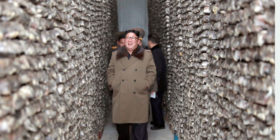The North Korean army has warned the US that its military has been cleared to wage an attack using “smaller, lighter and diversified nuclear” weapons.
“The moment of explosion is approaching fast,” the military said, warning that war could break out “today or tomorrow”.
The statement, carried by the Korean Central News Agency early on Thursday, said troops had been authorised to counter US aggression with “powerful practical military counteractions”.
The warning, the latest in a series of escalating threats against the US and South Korea, came after the Pentagon said it would deploy a missile defence system to the US Pacific territory of Guam to strengthen the region’s protections against a possible attack.
Meanwhile, a South Korean news agency reported that the North had moved a mid-range missile to its eastern coast..
Ban Ki-moon, the UN secretary-general, said that he was “deeply concerned” over rising tensions on Thursday.
‘Clear danger’
In an address to the National Defence University in Washington on Wednesday, Chuck Hagel, US defence secretary, labelled North Korea’s recent rhetoric as a threat to the US and its Asia-Pacific allies.
“Some of the actions they’ve taken over the last few weeks present a real and clear danger,” he said.
Hagel added that the US was doing all it could to defuse the situation.
Deployment of the Terminal High Altitude Area Defence System is the latest step the US has taken to bolster forces in the region in a far-reaching show of force aimed at countering the North Korean threat.
The Pentagon already has sent dispatched bombers, stealth fighters and ships.
Al Jazeera’s Harry Fawcet reports on the tensions on Korean peninsula
The land-based missile defence system includes a truck-mounted launcher, tracking radar, interceptor missiles and an integrated fire control system.
The Pentagon said the system would boost defences for US citizens in Guam, a US territory, and US forces stationed there.
North Korea has railed for weeks against joint US and South Korean military exercises taking place in South Korea and has expressed anger over tightened sanctions for a February nuclear test.
Following through on one threat on Wednesday, North Korean border authorities refused to allow entry to South Koreans who manage jointly run factories in the North Korean city of Kaesong.
Meabwhile, North Korea barred entry to a joint industrial complex it shares with the South for a second day, the South Korean Unification Ministry has said.
The ministry also said on Thursday that it would allow 222 South Korean workers to leave the zone through the day.
Shut down threat
North Korea also repeated its threat to shut down Kaesong industrial zone, where 123 South Korean firms operate factories, if the South’s government continued to insult it and worsen the situation by mentioning a possible military action against it.
“If the South’s puppet conservative group and its media continue bad-mouthing … we will be taking the stern measure of pulling out all of our workers from the Kaesong industrial zone,” KCNA news agency quoted the North’s Committee for the Peaceful Reunification of the Fatherland as saying.
Kaesong brings in $90m annually in wages to 53,000 North Korean workers and is one of the impoverished North’s few sources of ready cash.
South Korean workers were banned from entering the site, located 10km inside the North, on Wednesday amid a tense standoff with North Korea pitted against South Korea and the US.
Al Jazeera’s Harry Fawcett, reporting from the Paju border crossing, said that the longer Kaesong remains inaccessible to Seoul, “the bigger and more serious the situation becomes”.
The real test will come over the weekend when the factories in the complex begin to run low on supplies, he said.
‘Contingency plan’
The gates between North and South Korea will open 10 times on Thursday to allow workers to leave.
After the 222 South Korean workers leave between 10am and 5pm (01:00-08:00 GMT), another 606 workers from the South will remain in the Kaesong complex.
Spotlight coverage of tension in Northeast Asia
The operating stability of the complex is seen as a bellwether of inter-Korean relations, and its closure would mark a clear escalation of tensions beyond all the military rhetoric.
South Korea’s defence ministry said it had contingency plans, including possible military action, to ensure the safety of its citizens working in the joint industrial zone.
“We have prepared a contingency plan, including possible military action, in case of a serious situation,” Defence Minister Kim Kwan-jin told ruling party MPs in a meeting on Wednesday.
Border crossings for Kaesong had until Wednesday been functioning normally despite soaring tensions in recent weeks between the North and the South.
Pyongyang has been ramping up its threats since it was hit by international sanctions following its third nuclear test
earlier this year.





Leave a reply